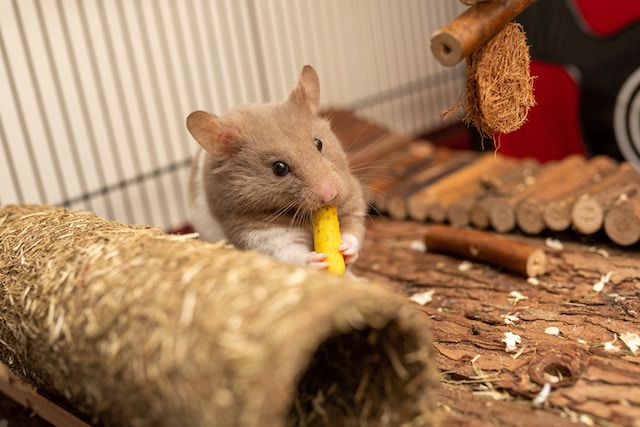Hamsters are popular pets loved for their small size, cute appearance, and playful nature. However, one question that often comes up among hamster owners is whether or not their pets can fall from heights.
While these tiny creatures may seem agile and nimble, there are concerns about their safety when climbing and jumping.
In general, hamsters are not known for their ability to climb or jump very high. Instead, ground-dwelling animals are more comfortable scurrying along the floor than scaling walls or leaping from high places.
However, this doesn’t mean they are immune to accidents or falls.
Several factors can increase the risk of a hamster falling from a height, including the type of enclosure they are in, the height of the fall, and the age and health of the hamster.
Can Hamsters Fall from Heights?
Hamsters are small and agile animals that can climb and jump. However, their small size and light weight make them vulnerable to injuries, especially when they fall from heights. This section provides an overview of whether hamsters can fall from heights and what happens when they do.
Factors that Affect Hamsters’ Falling Ability
Several factors can affect a hamster’s ability to fall from a height. These include the height of the fall, the surface they land on, and their age and health.
Young and healthy hamsters are more likely to survive a fall than older or sick hamsters.
The height of the fall is also a significant factor. Hamsters that fall from a higher height are more likely to sustain severe injuries or die than those that fall from a lower height.
Additionally, the surface they land on can impact the severity of their injuries. For example, a soft surface like a bed or a pillow can reduce the impact of the fall and prevent injuries.
What Happens When Hamsters Fall from Heights?
When hamsters fall from heights, they can sustain various injuries, including broken bones, internal bleeding, and organ damage. The severity of the injuries depends on the height of the fall, the surface they land on, and their age and health.
Hamsters that fall from a low height may only experience minor injuries like bruises or sprains. However, falls from higher heights can be fatal or cause severe injuries.
If a hamster falls and appears injured, it is essential to seek veterinary care immediately.
In conclusion, hamsters can fall from heights, and the severity of their injuries depends on several factors. Therefore, taking precautions to prevent falls and ensure hamsters have a safe and secure environment is crucial.
Preventing Hamster Falls
Cage and Habitat Design
Hamsters are small animals that can easily fall from heights, so it is essential to design their cages and habitats with safety in mind.
The cage size should be appropriate for the size of the hamster and should have multiple levels with ramps or ladders that are not too steep.
The cage floors should be solid, as wire mesh can cause foot injuries. Additionally, the cage should be made of sturdy materials that cannot be easily knocked over or damaged.
Supervision and Handling
Supervision is key when it comes to preventing hamster falls. Holding them securely and close to the ground is essential when handling a hamster.
Children should always be supervised when handling hamsters, as they may not understand the fragility of these small animals.
If a hamster is being taken outside its cage, it should be done in a secure and enclosed area where it cannot fall from a height.
Training and Taming
Training and taming a hamster can also help prevent falls. A well-trained hamster will be less likely to jump or climb out of its cage and will be more comfortable with being handled.
Training can be done through positive reinforcement, such as giving treats for good behavior. Taming can be done by spending time with the hamster daily, talking to it, and offering treats. A tame hamster will be more comfortable around people and less likely to try to escape.
In conclusion, preventing hamster falls requires careful consideration of cage and habitat design, close supervision and handling, and training and taming.
By following these guidelines, hamster owners can ensure the safety and well-being of their furry friends.
What to Do if Your Hamster Falls
Assessing Injuries
If your hamster falls from a height, the first thing to do is to assess the injuries. Check for any visible wounds, bleeding, or signs of distress. Hamsters are fragile animals, and falls can cause serious injuries, including broken bones, internal injuries, and head trauma.
Emergency Care and First Aid
If your hamster appears distressed or has visible injuries, you should provide emergency care and first aid. First, move your hamster to a warm, quiet, and safe place. Then, if there is any bleeding, apply pressure to the wound with a clean cloth or tissue.
If your hamster is unconscious, gently rub its body to revive it. You can also try giving your hamster a small amount of sugar water to help revive it.
Veterinary Attention
Even if your hamster appears okay after a fall, it is essential to seek veterinary attention. Hamsters are good at hiding their pain, and injuries may not be immediately apparent
. A vet can thoroughly examine for any internal injuries, broken bones, or other issues. They can also provide pain relief medication if necessary.
Follow-up Care
After your hamster receives veterinary attention, it is important to provide follow-up care. This may include administering medication, changing bandages, or providing special care to help your hamster recover.
Your vet will provide specific instructions based on your hamster’s injuries and condition.
Remember, prevention is always the best course of action. Ensure your hamster’s cage is secure and that there are no areas where your hamster can fall from a height. If you have concerns about your hamster’s health or safety, don’t hesitate to contact your vet for advice.




